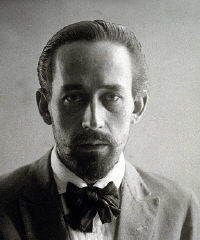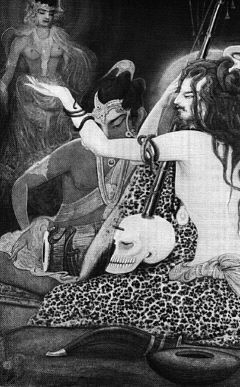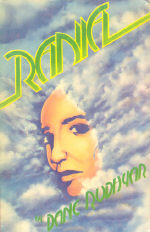
NEW YORK. 1925
Expanding Horizons: 1925-1929
Rudhyar went back and forth between New York and Hollywood during the years 1922, 1925, 1926, 1928, 1929 and 1930. During 1926 at the Yaddo Colony in upstate New York he completed the Moments. He continued writing articles, poems and music. The three Paeans were composed in 1925, Five Stanzas and Ouranos in 1927. In 1925 Rudhyar wrote a book entitled The Rediscovery of Music. Knopf was at first interested in the project, but found the finished manuscript impossible to sell. Other publishers agreed.
During this period Rudhyar became a musical associate and friend of Martha Graham, the Mother of Modern Dance, a close contemporary who he had first met while she was a member of the dance company of Ruth St. Denis and Ted Shawn in Hollywood. Rudhyar played piano improvisations for the rehearsals of some of Martha Grahamís earliest dance compositions, and in many ways her early work in dance paralleled Rudhyar's musical work.
Rudhyar's Dance Connection
From the beginning, Rudhyar's destiny brought him in close contact and collaboration with some of the most important and influential female dancers of the 20th Century. First there was VSP - Valentine de Saint-Point - the prototypic multimedia performance artist, who in her later years went to Egypt and became a Sufi. Then came Ruth St. Denis, little remembered today, but during the early-20th Century she was as famous as Isadora Duncan.
During her early years, Martha Graham and Rudhyar were so complementary - one in dance, the other in music - that they even looked alike, and Rudhyar improvised at the piano for the rehearsals of her earliest performed works. Rania, the heroine of his first novel, was also a woman of dance, whose movements possessed a magical force. In the late-1920s, Rudhyar also provided music for some of Doris Humphrey's dances. And, As we'll soon learn, Rudhyar's second wife, Eya Fechin, was a professional dancer and an early proponent of Psychodrama.
Rudhyar was also a friend of Srimati Ragini Devi, who in the 1920s encouraged him to write The Rebirth of Hindu Music. Named after the Vedic goddess of dance, this American woman left her well-placed husband, studied Indian music and dance, married an Indian man (with whom she bore Indirian, who became a famous dancer in her own right), and went on become a legendary figure, reviving the classical dance of India.
As is the case with other areas of Rudhyar's personality and destiny, it's best not to over-analyze Rudhyar's connection with dance and dancers. But it doesn't take the intrepid researcher long to discover a mythological
connection.

In the accompanying original watercolor by Promode Chatterjee, the Hindu deity Shiva, of which Rudra is a manifestation, is seated on a leopard skin, playing the harmony of the universe on a transcendent instrument made partly of a human skull. His son Ganesha accompanies him on the drum, beating out the rhythm of the cosmic pulse. By this divine invocation the goddess of dance and music, Ragini Devi, is brought into manifestation.
In 1927 Rudhyar began a new phase of his career, giving many lecture-recitals on modern music, as well as a series of talks on Oriental religions and philosophy. His first book of English poems Toward Man was published in Carmel, California in 1928. Other volumes of poetry were also written, a selection from which was published later under the title Of Vibrancy and Peace. White Thunder was published as a deluxe edition in Santa Fe, N. M. during 1938.
In 1928 To The Real in three sections was completed by the addition of a second movement and orchestrated. It was performed in Paris by Nicolas Slonimsky. Sinfonietta was also orchestrated at that time, and later performed in Washington D. C., and recorded in Germany.
That year Rudhyar lectured many times in Carmel, Los Angeles and Chicago. He also began a series of booklets under the general title of Seed Ideas, printed in Halcyon, California where in 1920 he had met Henry Cowell at the Temple of the People. Seven of these booklets were bound and published under the title Art as Release of Power. A second series began late in 1929, but only two were published.

Rania - Rudhyar's Epic Narrative
"RANIA is an epic narrative of the evolution of a woman's soul. It is the heroic pilgrimage of woman's being, exalted and enslaved, possessed and discarded, struggling for freedom. This is Rania's tortuous search for spiritual strength, ultimately sustaining her in her final battle with the powers of Darkness." So reads the back cover notes from the 1973 Unity Press edition of Rania.
In his Preface, Rudhyar writes that Rania is "the story of a strong and unusual woman's life filled with extremes of light and darkness, of beauty and tragedy. I conceived this work as a kind of symphonic narrative in three movements. I emphasized the poetic-musical form by writing at first short stanza-like paragraphs, then, as the action became less tense and precipitated, increasing the length of these stanzas. The second part of the symphonic-narrative the action slows down, and the stanza-form is no longer needed. It reappears in the third part which ends with a recall of the initial heroic theme of the sacrifice of the seed. In RANIA the action is condensed, often stark, moving from high-point to high-point - today one would probably speak of "peak-experiences." The characters are projected on the background of social or natural landscapes which are broadly drawn and essentailized.
Many of the work's scenes, themes and characters were drawn from Rudhyar's experiences in Hollywood and Carmel, and the leading characters are based loosely on his spiritual friends Aryel Darma and B.P. Wadia.
During January 1929 in Chicago, Rudhyar wrote Rania: An Epic Narrative. The manuscript was presented repeatedly to publishers who declined to publish it because it was too unusual a work, half poem, half novel. In March 1972 it was read by James Shere in several installments at the radio station KPFA Berkeley, during a month dedicated to the broadcasting of works by Rudhyar, interviews, comments, music, and other work. Rania was eventually published by Stephen Levine's Unity Press in 1973.